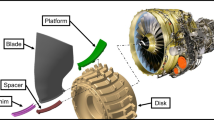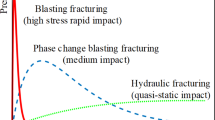Abstract
The initiation and growth of fatigue cracks in the runner blades of hydraulic units is one of the major causes that limit their service life. Practice shows that the current diagnostic systems for hydraulic units do not permit timely identification of cracks in the operating equipment. The data from the numerical experiment demonstrate that high stiffness and the existence of particular eigenmodes in the structure do not enable the dynamic stresses in the blades responsible for crack initiation to be linked to the parameters controlled by the diagnostic system. Analytical approaches based on evaluation of the fatigue strength and fracture mechanics can help solve this problem.


Similar content being viewed by others
REFERENCES
GOST (State Standard) R 55890–2013: Unified Power Systems and Isolated Power Systems. Operational Dispatch Control. Regulation of Frequency and Active Power Flows. Norms and Requirements.
Trivedi, C., Gandhi, B., and Michel, C.J., Effect of transients on Francis turbine runner life: A review, J. Hydraul. Res., 2013, vol. 51, no. 2, p. 112. https://doi.org/10.1080/00221686.2012.732971
Marmont, H., Chamberland-Lauzon, J., Skagerstrand, A., Coutu, A., and Carlevi, J., Cost of enlarged operating zone for an existing Francis runner, IOP Conf. Ser.: Earth Environ. Sci., 2016, vol. 49, p. 072018. https://doi.org/10.1088/1755-1315/49/7/072018.
Flores, M., Urquiza, G., and Rodriguez, J.M., A fatigue analysis of a hydraulic Francis turbine runner, World J. Mech., 2012, no. 2, p. 28. https://doi.org/10.4236/wjm.2012.21004
Huang, X., Oram, C., and Sick, M., Static and dynamic stress analyses of the prototype high head Francis runner based on site measurement, IOP Conf. Ser.: Earth Environ. Sci., 2014, vol. 22, no. 3, p. 032052. https://doi.org/10.1088/1755-1315/22/3/032052.
Favrel, A., Gomes Pereira Junior, J., Müller, A., Landry, C., Yamamoto, K., and Avellan, F., Swirl number based transposition of flow-induced mechanical stresses from reduced scale to full-size Francis turbine runners, J. Fluids Struct., 2020, vol. 94, p. 102956. https://doi.org/10.1016/j.jfluidstructs.2020.102956
Unterluggauer, J., Doujak, E., and Bauer, C., Fatigue analysis of a prototype Francis turbine based on strain gauge measurements, Wasser Wirtsch., 2019, vol. 09, no. S1, p. 66. https://doi.org/10.1007/s35147-019-0238-9
Liu, X., Luo, Y., and Wang, Z., A review on fatigue damage mechanism in hydroturbines, Renewable Sustainable Energy Rev., 2016, vol. 54, p. 1. https://doi.org/10.1016/j.rser.2015.09.025
Seidel, U., Mende, C., Hubner, B., Weber, W., and Otto, A., Dynamic loads in Francis runners and their impact on fatigue life, IOP Conf. Ser.: Earth Environ. Sci., 2014, vol. 22, no. 3, p. 32054. https://doi.org/10.1088/1755-1315/22/3/032054.
Nennemann, B., Monette, C., and Chamberland-Lauzon, J., Hydrodynamic damping and stiffness prediction in Francis turbine runners using CFD, IOP Conf. Ser.: Earth Environ. Sci., 2016, vol. 49, no. 7, p. 072006. https://doi.org/10.1088/1755-1315/49/7/072006.
Habibzadeh, B.H., Viens, M., Tahan, S.A., and Gagnon, M., On the performance of nondestructive testing methods in the hydroelectric turbine industry, IOP Conf. Ser.: Earth Environ. Sci., 2014, vol. 22, no. 1, p. 12018.
Balauntescu, I. and Panaitescu, V., Low frequency pressure pulsations at high load in a Francis turbine, U.P.B. Sci. Bull., Ser. D, 2016, vol. 78, no. 4.
Frunzăverdel, D., Muntean, S., Mărginean, G., Câmpiani, V., Marşavina, L., Terzi, R., and Şerban, V., Failure analysis of a Francis turbine runner, IOP Conf. Ser.: Earth Environ. Sci., 2010, vol. 12, p. 012115. https://doi.org/10.1088/1755-1315/12/1/012115.
Stationary System for Vibration Control, Monitoring, and Diagnostics of Hydraulic Units ALMAZ-7010-GES. http://www.diamech.ru/almaz_ges.html.
Selak, L., Butala, P., and Sluga, A., Condition monitoring and fault diagnostics for hydropower plants, Comput. Ind., 2014, vol. 65, no. 6, pp. 924–936. https://doi.org/10.1016/j.compind.2014.02.006
Zhang, M., Valentin, D., Valero, C., Egusquiza, M., and Zhao, W., Numerical study on the dynamic behavior of a Francis turbine runner model with a crack, Energies, 2018, vol. 11, p. 1630. https://doi.org/10.3390/en11071630
Panov, K.A., Strength tests of blades of radial-axial turbines at Ust-Ilimsk HPP, Gidravlicheskie mashiny, gidropnevmoprivody i gidropnevmoavtomatika. Sovremennoe sostoyanie i perspektivy razvitiya. Nauchnye trudy Mezhdunarodnoi nauchno-tekhnicheskoi konferentsii (Hydraulic Machines, Hydraulic Pneumatic Drives, and Hydraulic Pneumatic Automatics: The Current State and Development Prospects: Proc. Int. Sci.-Tech. Conf.), St. Petersburg, 2016, p. 86.
Georgievskaya, E.V., On the relationship of vibrations and dynamic stresses in the blade system of hydraulic turbines, Izv. VNIIG im. B.E. Vedeneeva, 2017, vol. 283, p. 54.
Georgievskaia, E., Hydraulic turbines lifetime in terms of fracture mechanics, Eng. Failure Anal., 2019, vol. 105, p. 1296.
Åsnes, A., Willersrud, A., Kretz, F., and Imsland, L., Predictive maintenance and life cycle estimation for hydro power plants with real-time analytics, Conf.: Hydro 2018, Gdansk, 2018. https://www.researchgate.net/publication/328879561.
Funding
This work was carried out within the framework of the Skolkovo Foundation project “Complex for Predictive Analytics of Equipment Technical Condition Parameters” and received funding from the Foundation for Assistance to Small Innovative Enterprises in Science and Technology (FASIE), grant agreement no. 3288GS1/55639, and the Skolkovo Innovation Сenter, grant agreement no. 40113/07002/0329-2020.
Author information
Authors and Affiliations
Corresponding author
Ethics declarations
The author declares that there is no conflict of interest.
Additional information
Translated by N. Bogacheva
About this article
Cite this article
Georgievskaia, E.V. The Problem of Early Crack Detection in the Runner Blades of Hydraulic Units. J. Mach. Manuf. Reliab. 50, 216–221 (2021). https://doi.org/10.3103/S1052618821030043
Received:
Accepted:
Published:
Issue Date:
DOI: https://doi.org/10.3103/S1052618821030043




